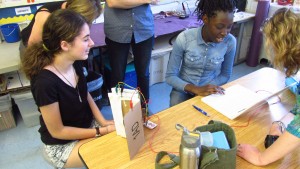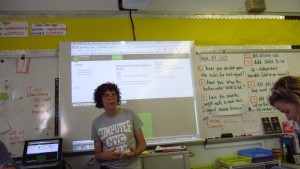22 June 2015
Today included a visit to the oddly-named Computer School in Manhattan, to see Tracy Rudzitis and her work with Primary classes and technology.
This included a number of coding classes, including the use of Starlogo Nova to simulate population dynamics for predatpr/prey situations and infectious disease propagation. The modelling was quite straightforward using this tool, and students were quite fluent in describing the role of randomness and variables in this modelling.

Students with interactive book
Tracy has also set up a lunchtime makerspace where students were building interactive toys and devices using MaKey MaKey devices and home-made sensors. This included a digital book that used foil on pages to trigger various actions as the reader turned pages.
Key learnings:
Primary and middle school students are quite capable of developing computer models when suitably scaffolded and when tools such as Scratch or Starlogo Nova are used.
It is very easy for digital technologies to become the province of a computer specialist. The fact that mathematical modelling was happening here and not in a mathematics or science class seems odd.
It is worth mentioning that the name “Computer School” is a legacy from the school’s origins in the 1980s, which included close cooperation with Seymour Papert (eg, paper 1 and paper 2)
In 1983, a new school was born in the basement of the O’Shea complex on W. 77th Street. Premised on the notion that technology could be a vibrant teaching tool, The Computer School was one of the first schools to integrate computers into the classroom while providing a rigorous, innovative and broad-based curriculum to its students.
Today, the school’s premise is a given: computers are an integral part of the classroom – and the school’s name, which reflects its pioneering philosophy, tells only part of the story.
While it’s true that Computer School students receive regular instruction in cutting edge digital media, they are also exposed to a richly inter-disciplinary curriculum that excites their minds and touches their hearts. And as part of a highly diverse community that hails from many different cultures, races, religions and economic backgrounds, they learn invaluable lessons from each other – as well as from the school’s challenging academics.
I think it is fair to say that the influence of things like Common Core standards have meant that computing now is seen as less critical than some of the other curriculum areas at the Computer School.
Specific considerations for DoE Tasmania
- Digital Technologies in the Primary sector needs to be integrated into current and traditional curriculum areas rather than be seen as an additional task.
- With careful planning, Digital Technologies and Design and Technologies could be integrated for teaching purposes, but assessment remains problematic. Being proficient in one need not indicate proficiency in the other. The assessment/reporting expectations need some more thought.
- Despite the first point, mandated testing and reported performance measures can skew a curriculum very seriously, by messaging that some areas are more important than others. This has implications for areas such as Design and Technologies and Digital Technologies (and possibly others).


